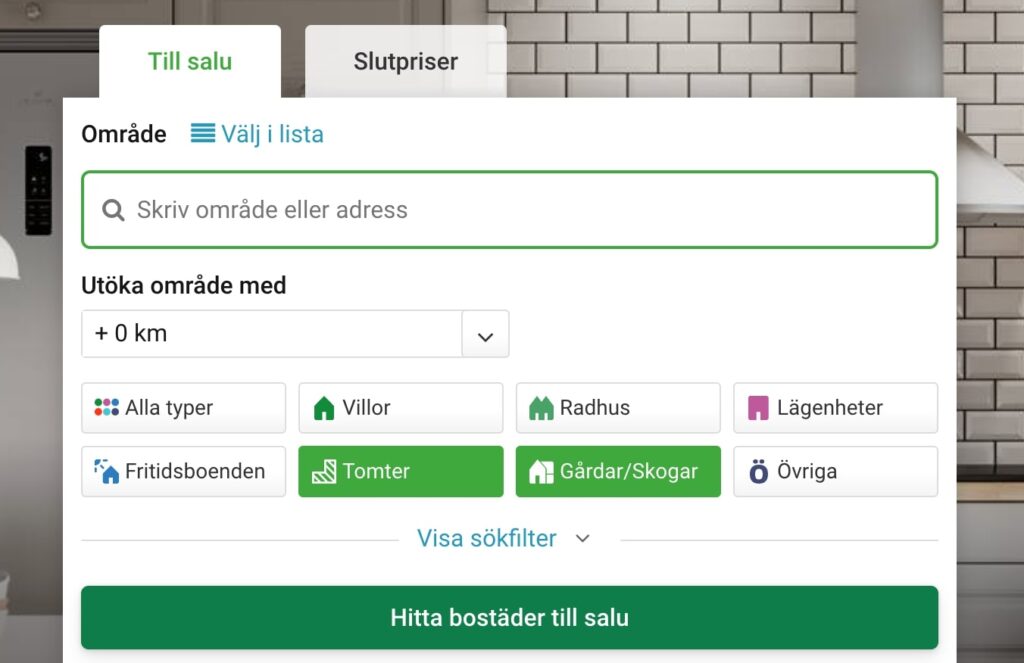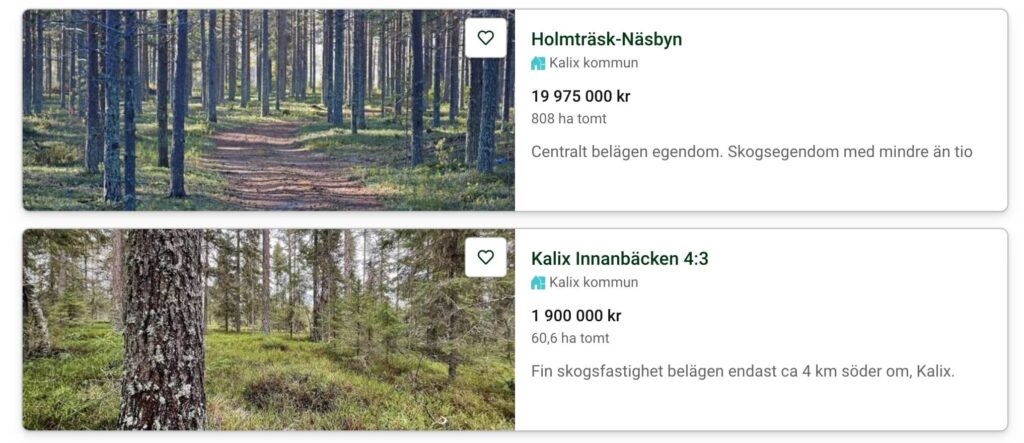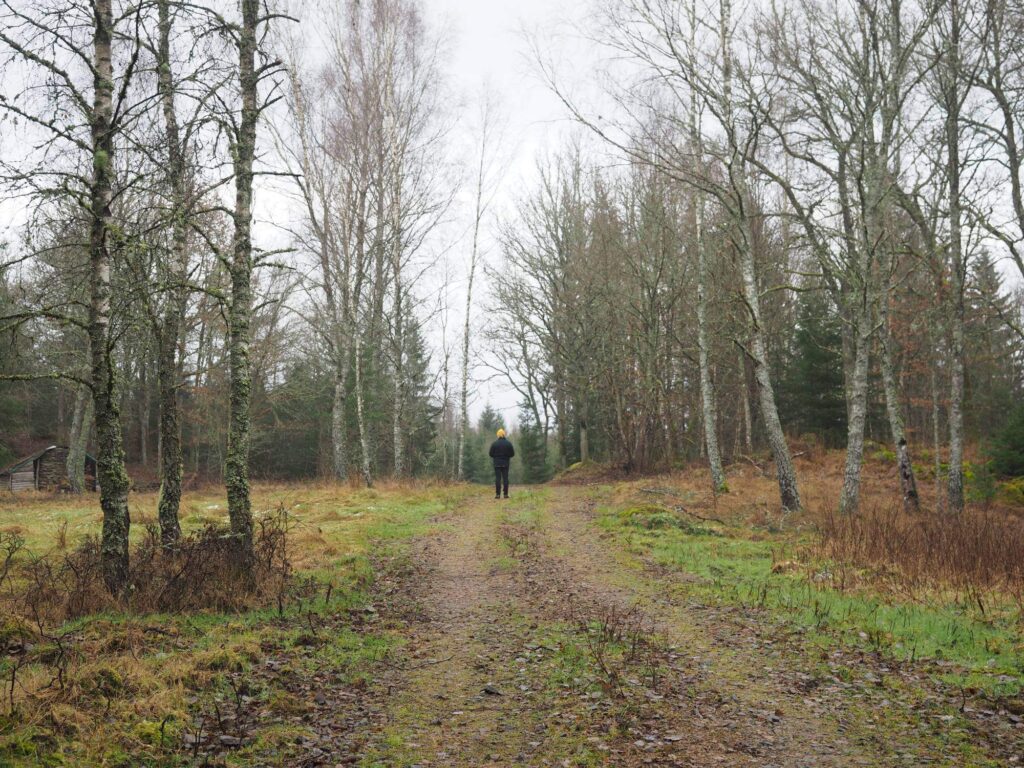Sweden is a country known for its natural beauty, with forests, lakes, and mountains that offer countless opportunities for outdoor activities and slow nordic living. Buying land in Sweden can provide a peaceful and scenic place to live, as well as a potential source of income through tourism.
For me, it all started with the desire to have a second home close to nature, and Google translated “buy a forest” into Swedish, and pasted it into Google.
How to find cheap land for sale in Sweden
Through my initial Google searches and translating “buy a forest”, I found a site/app called Hemnet. The equivalent for UK folks would be Rightmove.
On the app and website, you can search for “Tomter” (empty plots), “Gård/skogar” (farm/forest). You can draw on a map or enter the “län” (county), or the “kommun” (council) and sort by price etc. Everything is in Swedish, so you have to Google translate your way out of it. Once you have a set of defined criteria, you can save the search and get emails sent when new plots come up for sale.

Which areas should you look for?
There are obviously no right or wrong answers to this question. It all depends.
It was a matter of distance to Copenhagen (my home), and how far I would want to drive back and forth – about 2-3 hours. I had no initial preference for the area but had criteria for the land itself.
My best advice: keep an open mind.
Sweden is huge and nature is here, there and everywhere. The further north, the more spectacular landscape you will get (in my opinion) and you can experience the midnight sun, aurora borealis, excellent skiing etc. There are also plenty of airports and train tracks throughout Sweden making it easier to access different parts of the country – depending on where you live.
What about real estate agents?
Of course, there are plenty of local Swedish “fastighetsbyrån” (estate agents), but as a foreigner, it’s much easier to find the available plots and properties on a site like Hemnet, instead of researching local estate agents.

I found my land advertised by a Danish estate agent called Dansk Ejendoms Consult. They primarily focus on Danes buying in Sweden. The reason for their existence is, that Danes through generations have enjoyed vacationing in Sweden. As primitive properties (called “ødegårde” in Danish) have been cheap for decades, many have chosen to buy their summerhouse in Sweden instead of Denmark where you won’t find the exact nature, plot sizes and distance to neighbours ( prices). It’s a large community that calls themselves “danske torpare” (“torp” meaning a smaller agricultural property).
It’s my impression that most people, both Danes and Swedes, chose to buy a house instead of land. The people buying land will more likely do it for investment (tax-free), hobbies (hunting) or industrial purposes (logging). Therefore you will find lots of huge plots on sale, and fewer of the more digestible ones (price and size).
Can foreigners buy land in Sweden?
The short answer is: yes. Foreigners can buy land in Sweden, and it’s surprisingly straightforward.
What to look for, when researching land for sale
Although buying land in Sweden as a foreigner is easy, the part of buying land in a foreign country in itself is a bit nerve-wracking when you don’t know the language that well, the rules and regulations, the culture and so forth. Here are some of the tips I would give to others looking to buy land (a more extensive post on the topic will come later):
- Be sure to check if the land is “Äganderätt” – meaning you will own and not lease it. It will say in the real estate ad whether or not that’s the case.
- If you plan on building (some buy land for tax-free investment and do nothing with it) I would recommend checking to see if there is anything on your site that may make getting building permission harder, and contact the local kommun’s “miljö- och byggenheten” (environmental- and planning department) to see if there have been any rejected applications before you buy.
How to buy land in Sweden as a foreigner
When you buy land or property in Sweden you put in an offer. The highest bid is often made public on the estate agent’s website, but if not, the estate agent will call/text to update you when you have been outbid. In the same way, you can reach out to a real estate agent and ask about the current bid, before placing yours.
Then, if you are the highest bidder, you win the right to apply to buy it. If the seller accepts, you fill out some paperwork and then it’s yours!
The paperwork I filled out included:
- Purchasing contract (Köpekontrakt)
- Letter of purchase (Köpebrev)
- Deposit agreement (Depositionsavtal – handpenning)
- Deed of Renunciation (Avstående från boendekalkyl)
From the time I went to see the land to signing the papers, it took 5 days. It took a bit longer for my ownership to be processed officially.
What does it cost to buy land in Sweden?
You pay the cost of the land, some charges (see below) and 1.5% to the Swedish tax agency “skatteverket”. Land is non taxable so there are no ongoing taxes on empty land/forest. There is also a tax on capital gains when you sell, around 20%.
Purchasing costs
To give you an insight into the purchasing costs, here are the costs I paid for my land in December 2020:
- Deed – Sek. 825,00
- Transcript in the record book – Sek. 100,00
- Stamp duty – Sek. 2.200,00
- Rectification fee to the real estate agent – Sek. 1.300,00
- Tax on rectification fee Sek. 325,00
In total, I paid 4.750 SEK in purchasing costs. I bought the land as a cash sale, but if you were to take out a mortgage for buying you would of course have additional costs.
Seeing the land before bidding and buying
I bought my land in December 2020, right before Denmark and Sweden went into a border-closing fight due to the pandemic – lucky!
A Friday evening an email from Hemnet landed in my inbox listing what was for sale within my criteria, and here I noticed a cheap chunk of land in Småland – an area I had no real knowledge of at the time. The following day I put in the coordinates on Google Maps and drove about 2 hours north of Copenhagen. Land most likely won’t have an address you can put into your GPS or Google Maps, but either coordinates and/or a plot ID.
I mapped out the land to the best of my ability to get a sense of both the size and what was on it. It’s hard to know exactly what you’re buying when the leaves have fallen off the deciduous trees and ferns have died back, but for this part, it was, for me, all about gut feeling – and it felt right.
As with any bigger purchase, I would however strongly advice seeing the place before buying, if at all possible.

